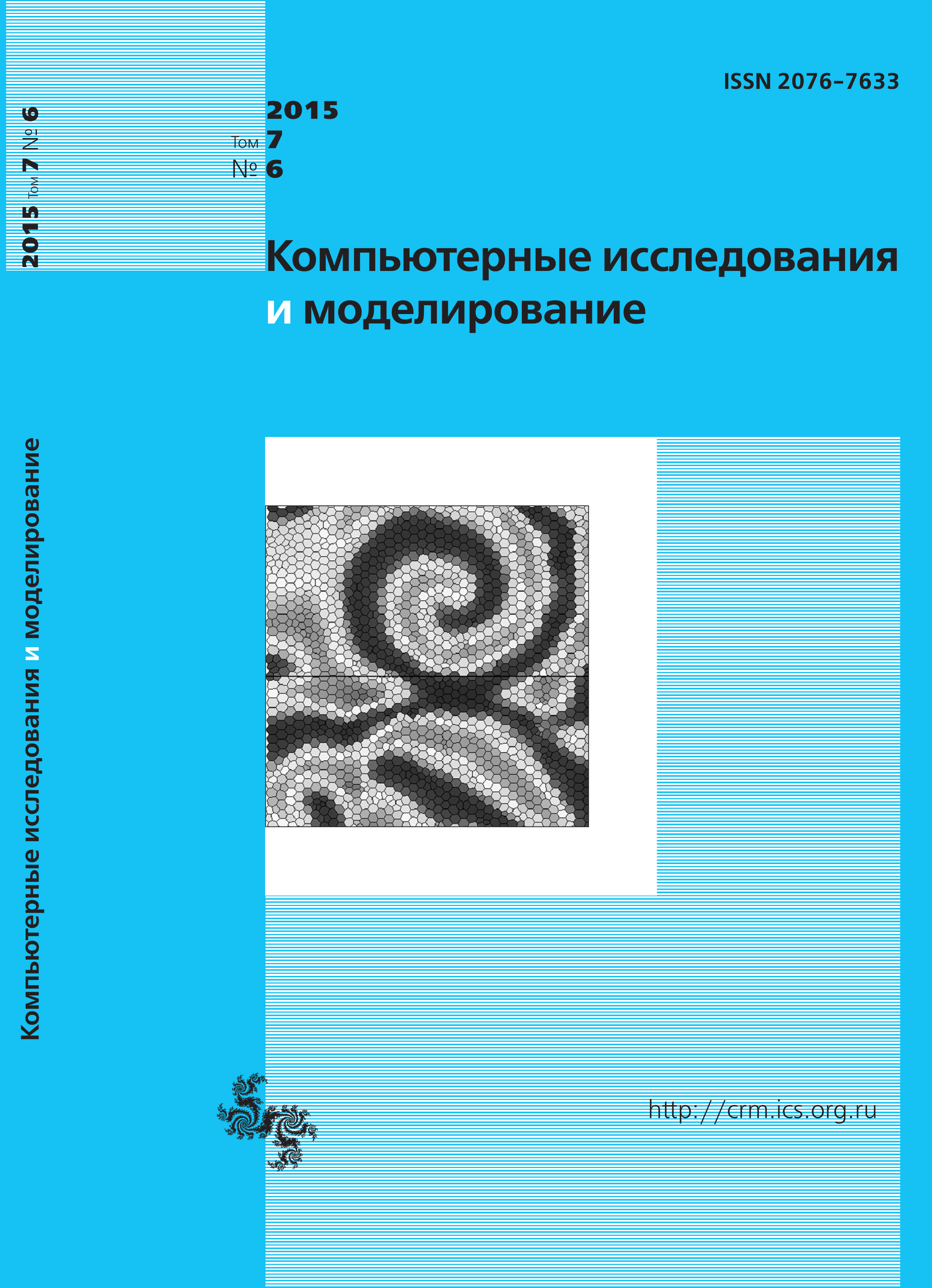All issues
- 2025 Vol. 17
- 2024 Vol. 16
- 2023 Vol. 15
- 2022 Vol. 14
- 2021 Vol. 13
- 2020 Vol. 12
- 2019 Vol. 11
- 2018 Vol. 10
- 2017 Vol. 9
- 2016 Vol. 8
- 2015 Vol. 7
- 2014 Vol. 6
- 2013 Vol. 5
- 2012 Vol. 4
- 2011 Vol. 3
- 2010 Vol. 2
- 2009 Vol. 1
Investigation of individual-based mechanisms of single-species population dynamics by logical deterministic cellular automata
Investigation of logical deterministic cellular automata models of population dynamics allows to reveal detailed individual-based mechanisms. The search for such mechanisms is important in connection with ecological problems caused by overexploitation of natural resources, environmental pollution and climate change. Classical models of population dynamics have the phenomenological nature, as they are “black boxes”. Phenomenological models fundamentally complicate research of detailed mechanisms of ecosystem functioning. We have investigated the role of fecundity and duration of resources regeneration in mechanisms of population growth using four models of ecosystem with one species. These models are logical deterministic cellular automata and are based on physical axiomatics of excitable medium with regeneration. We have modeled catastrophic death of population arising from increasing of resources regeneration duration. It has been shown that greater fecundity accelerates population extinction. The investigated mechanisms are important for understanding mechanisms of sustainability of ecosystems and biodiversity conservation. Prospects of the presented modeling approach as a method of transparent multilevel modeling of complex systems are discussed.
Supplementary information:
Movies of the computer experiments are presented in the form of GIF animations (Visualizations 1-16). GIF animations are started and restarted automatically. To be able to stop a movie on a specific iteration, you need to download the movie and open it in a video player, for example, in Media Player Classic. Each movie demonstrates iterations of a cellular automaton with the number of individuals on the lattice at each iteration.
Visualization 1. Model 1 with Moore neighborhood.
Visualization 2. Model 1 with hexagonal neighborhood.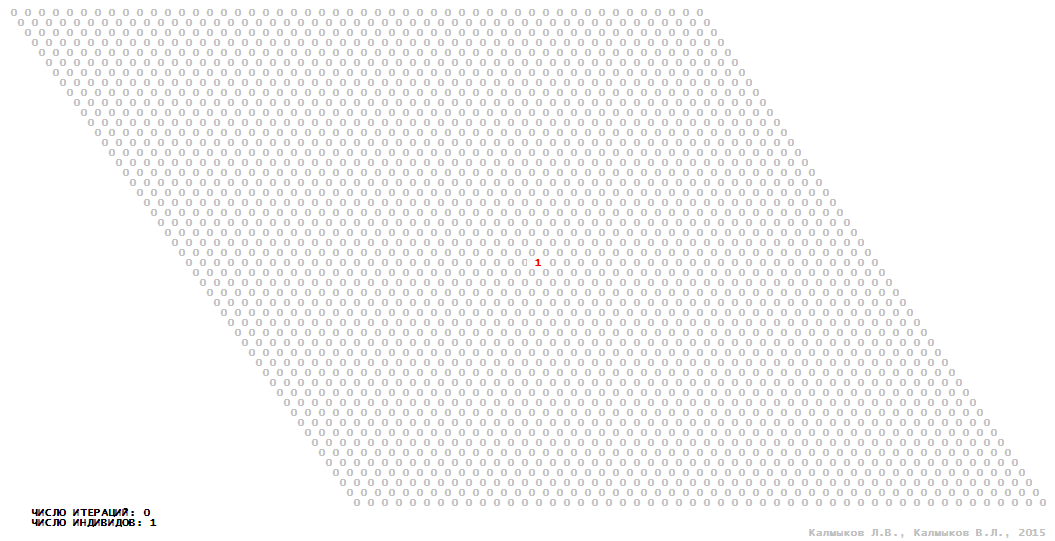
Visualization 3. Model 1 with von Neumann neighborhood.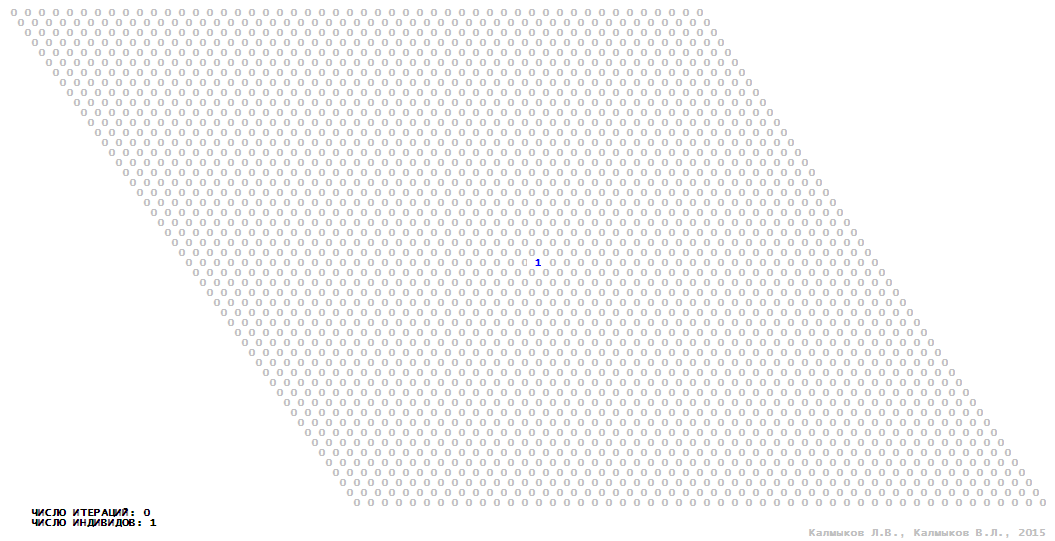
Visualization 4. Model 1 with tripod neighborhood.
Model 1 (Visualizations 1–4) is a logical deterministic cellular automaton with two states. A set of possible states of each lattice site is {0, 1}. Cellular automaton lattice consists of 50x50 sites and it is closed by periodic conditions on the torus. Resource regeneration of a microhabitat and recycling of a dead individual occur simultaneously with life activity of a new individual which has occupied this microhabitat. The following symbols are used to indicate the states of cellular automaton cell: {0} – a microhabitat is free; {1} – a microhabitat is occupied by an individual. Using various neighborhoods we investigate the impact of the number of offsprings and of their positioning in space on population dynamics. Population growth curves have S-shaped form and are shown in Figure 10a. In all four cases a successful colonization of free habitat occurred and species continued to exist indefinitely long.
Visualization 5. Model 2 with Moore neighborhood.
Visualization 6. Model 2 with hexagonal neighborhood.
Visualization 7. Model 2 with von Neumann neighborhood.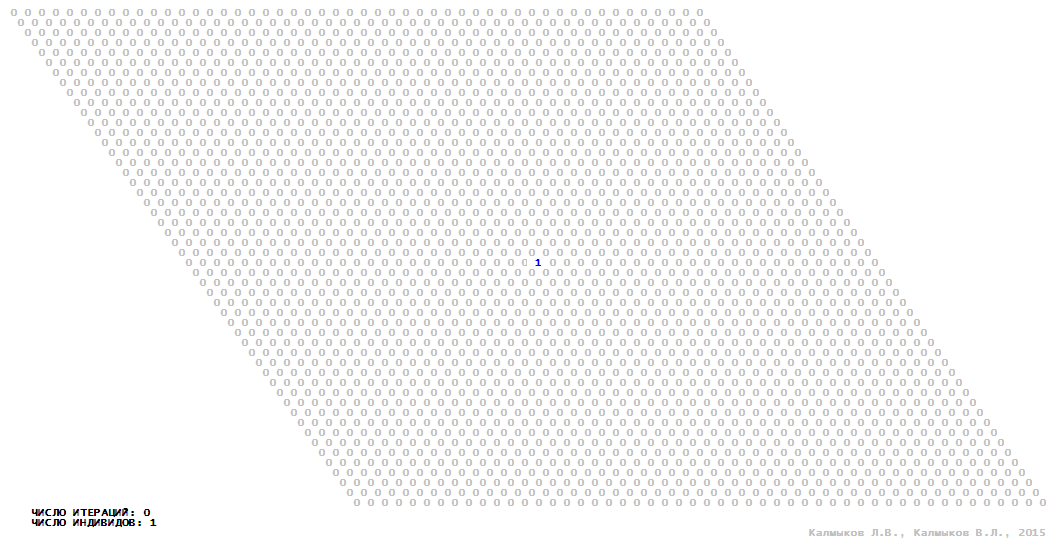
Visualization 8. Model 2 with tripod neighborhood.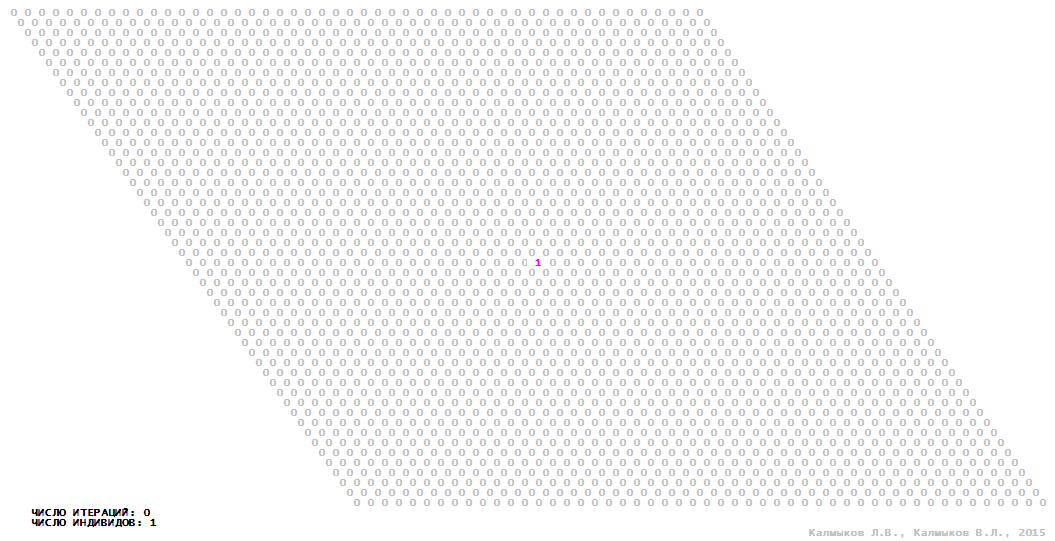
Model 2 (Visualizations 5–8) is a logical deterministic cellular automaton withthree states. A set of possible states of each lattice site is {0, 1, 2}. Cellular automaton lattice consists of 50x50 sites and it is closed by periodic conditions on the torus. Resource regeneration of a microhabitat includingrecycling of a dead individual takesone iteration. The following symbols are used to indicate the states of cellular automaton cell: {0} – a microhabitat is free; {1} – a microhabitat is occupied by an individual; {2} – a microhabitat is in the regeneration state which takes one iteration. Using various neighborhoods we investigate the impact of the number of offsprings and their positioning in space on population dynamics. Population growth curves have S-shaped formwhenMoore, hexagonal and von Neumann neighborhoods are used (Fig. 10б). Population growth curve has double S-shaped form when thetripod neighborhood is used (Fig. 10б). In all four cases there is a successful colonization of free habitat and the species exists indefinitely long.
Visualization 9. Model 3 with Moore neighborhood.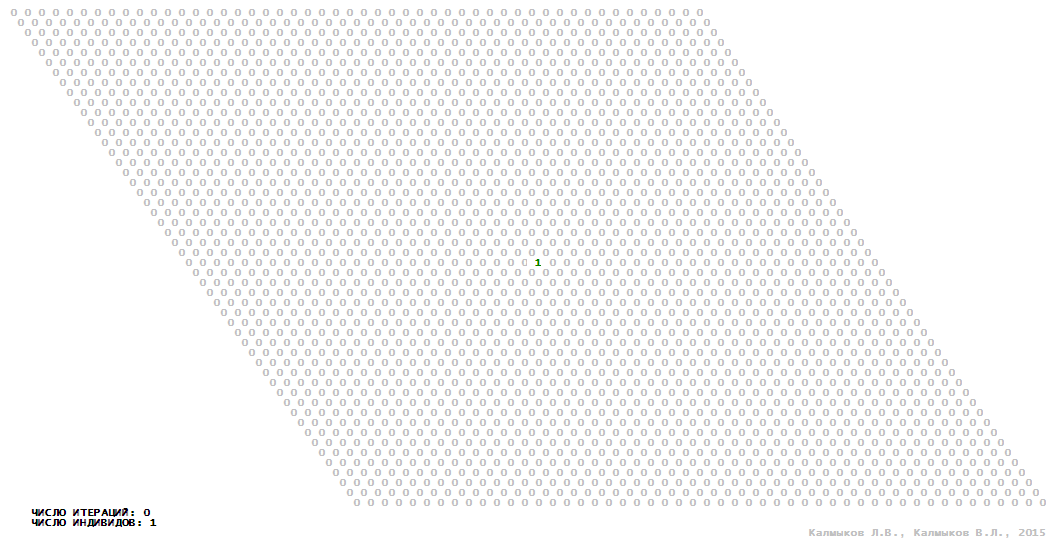
Visualization 10. Model 3 with hexagonal neighborhood.
Visualization 11. Model 3 with von Neumann neighborhood.
Visualization 12. Model 3 with tripod neighborhood.
Model 3 (Visualizations 9–12) is a logical deterministic cellular automaton with four states. A set of possible states of each lattice site is {0, 1, 2, 3}. Cellular automaton lattice consists of 50x50 sites and it is closed by periodic conditions on the torus. Resource regeneration of a microhabitat including recycling of a dead individual takes two iterations. The following symbols are used to indicate the states of cellular automaton cell: {0} – a microhabitat is free; {1} – a microhabitat is occupied by an individual; {2, 3} – a microhabitat is in the regeneration state which takestwo iterations. Using various neighborhoods we investigate the impact of the number of offsprings and their positioning in space on population dynamics. Population growth curves show a linear growth, which is sharply replaced by decreasing of population number, leading to population extinction (Fig. 10в), i.e. a population catastrophe occur. The population catastrophe is occurred when Moore, hexagonal and von Neuman neighborhoods are used. Population growth curve has double S-shaped form whenthe tripod neighborhood is used (Fig. 10в). In this case a successful colonization of free habitat occured and species population continued to exist indefinitelylong.
Visualization 13. Model 4 with Moore neighborhood.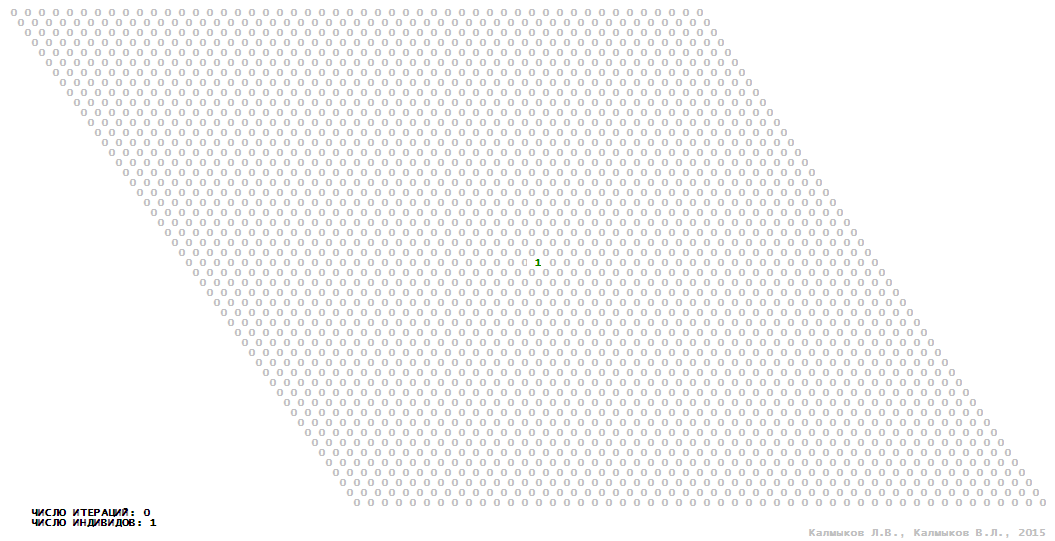
Visualization 14. Model 4 with hexagonal neighborhood.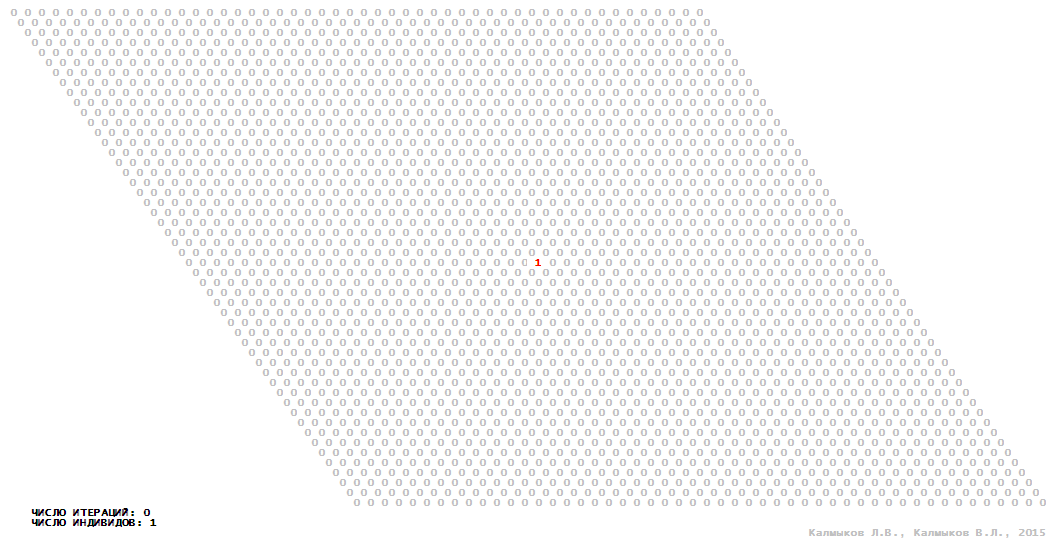
Visualization 15. Model 4 with von Neumann neighborhood.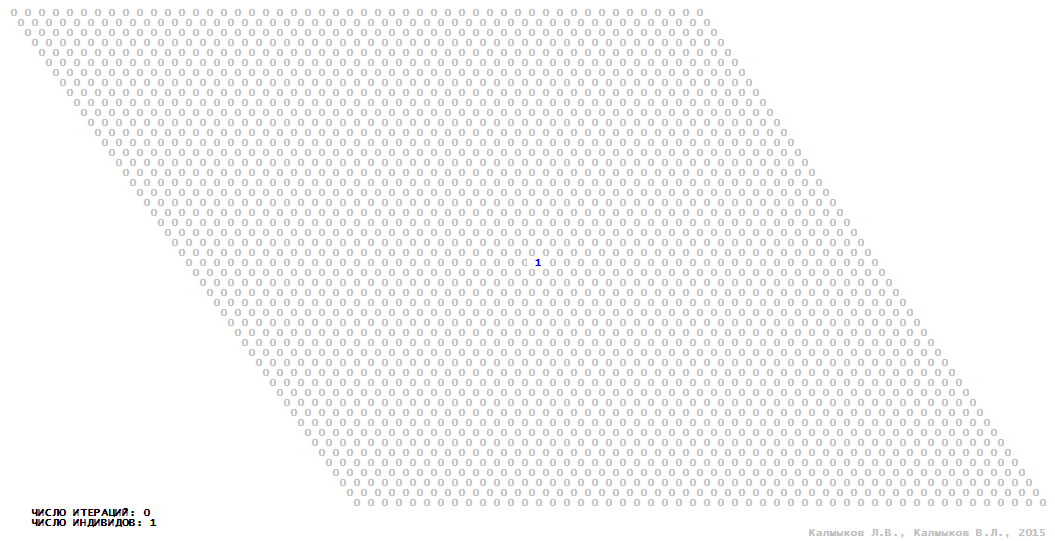
Visualization 16. Model 4 with tripod neighborhood.
Model 4 (Visualizations 13–16) is a logical deterministic cellular automaton with five states. A set of possible states of each lattice site is {0, 1, 2, 3, 4}. Cellular automaton lattice consists of 50x50 sites and it is closed by periodic conditions on the torus. Resource regeneration of a microhabitat including recycling of a dead individual takesthree iterations. The following symbols are used to indicate the states of cellular automaton cell: {0} – a microhabitat is free; {1} – a microhabitat is occupied by an individual; {2, 3, 4} – a microhabitat is in the regeneration state which takesthree iterations. Using various neighborhoods we investigate the impact of the number of offsprings and their positioning in space on population dynamics. In all four cases population growth curves show a linear growth, which is sharply replaced by decreasing of population number, leading to extinction of the populations, i.e. a population catastrophe occur (Fig. 10г).
Copyright © 2015 Kalmykov L.V., Kalmykov V.L.
Views (last year): 16. Citations: 3 (RSCI).Indexed in Scopus
Full-text version of the journal is also available on the web site of the scientific electronic library eLIBRARY.RU
The journal is included in the Russian Science Citation Index
The journal is included in the RSCI
International Interdisciplinary Conference "Mathematics. Computing. Education"





